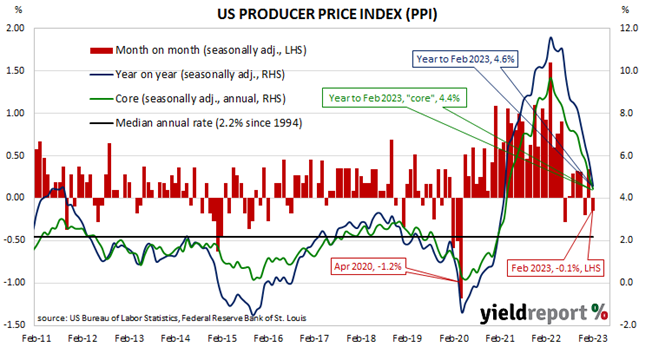Summary: US producer price index (PPI) down 0.1% in February, fall contrasts with expectations; annual rate slows to 4.6%; “core” PPI flat; Treasury yields fall dramatically; rate-rise expectations soften significantly; goods prices down 0.2%, services prices down 0.1%.
Around the end of 2018, the annual inflation rate of the US producer price index (PPI) began a downtrend which continued through 2019. Months in which producer prices increased suggested the trend may have been coming to an end, only for it to continue, culminating in a plunge in April 2020. Figures returned to “normal” towards the end of that year but annual rates through 2021 and 2022 have been well above the long-term average.
The latest figures published by the Bureau of Labor Statistics indicate producer prices decreased by 0.1% after seasonal adjustments in February. The decline contrasted with the 0.3% increase which had been generally expected as well as January’s 0.3% rise after it was revised down from 0.7%. On a 12-month basis, the rate of producer price inflation after seasonal adjustments and revisions slowed from 5.7% in January to 4.6%.
Producer prices excluding foods and energy, or “core” PPI, remained steady after seasonal adjustments. The result was noticeably lower than the expected 0.4% increase and less than January’s 0.1% rise but the annual rate still slowed from January’s revised figure of 5.0% to 5.4%.
US Treasury bond yields fell dramatically on the day as news of a major European bank seeking assistance from the Swiss National Bank became public. By the close of business, the 2-year Treasury yield had dropped by 36bps to 3.89%, the 10-year yield had shed 23bps to 3.46% while the 30-year yield finished 16bps lower at 3.65%.
In terms of US Fed policy, expectations of higher federal funds rates over the next 12 months softened significantly. At the close of business, contracts implied the effective federal funds rate would average 4.6175% in March, 4bps higher than the current spot rate, and then climb to an average of 4.71% in April. May futures contracts implied a 4.835% average effective federal funds rate while March 2024 contracts implied 3.695%.
The BLS stated higher prices for final demand good fell by 0.2% on average. Prices of final demand services fell by 0.1%.
The producer price index is a measure of prices received by producers for domestically produced goods, services and construction. It is put together in a fashion similar to the consumer price index (CPI) except it measures prices received from the producer’s perspective rather than from the perspective of a retailer or a consumer. It is another one of the various measures of inflation tracked by the US Fed, along with core personal consumption expenditure (PCE) price data.


